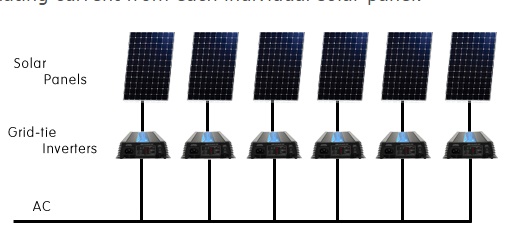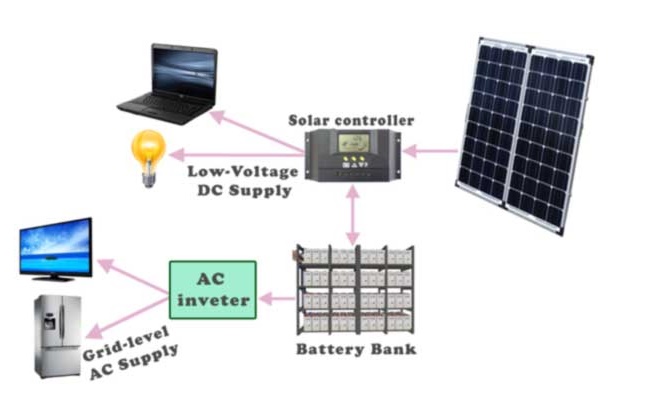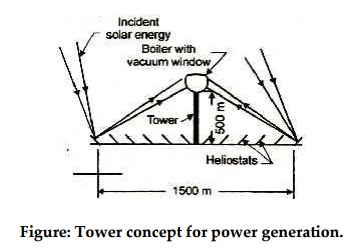Chapter: Mechanical and Electrical : Power Plant Engineering : Power From Renewable Energy
Construction and working principle of Solar power plant
Construction and working principle of Solar power plant
Figure shows a solar power plant with a low temperature
solar engine using heated water from flat plate solar collector and Butane as
the working fluid. This was developed to lift water for irrigation purposes.

1. Solar collectors
a) Flat plate collector

Figure: Flat plate collector
In
a flat plate collector (figure), the radiation energy of the sun falls on a
flat surface coated with black paint having high absorbing capacity. It is
placed facing the general direction of the sun. The materials used for the
plate may be copper, steel aluminium. The thickness of the plate is 1 to 2 mm.
Tubing of copper is provided in thermal contact with the plate.
Heat
is transferred from the absorbed plate to water which is circulated in the
copper tubes through the flat plate collection.
Thermal
insulation is provided behind the absorber plate to prevent heat losses from
the rear surface. Insulating material is generally fibre glass or mineral wool.
The front cover is made up of glass and it is transparent to the incoming solar
radiations.
b) Cylindrical parabolic concentrator
collector
Concentrator
collectors (figure) are of reflecting type utilizing mirrors. The reflecting
surface may be parabolic mirror. The solar energy falling on the collector
surface is reflected and focused along a line where the absorber tube is
located. As large quantity of energy falling on the collector surface is
collected over a small surface, the temperature of the absorber fluid is very
much higher than in flat plate collector.
While
flat place collectors may be used to heat water upto 80°C (low
temperature), the concentrating type of collectors are designed to heat water
to medium and high temperature ranges.
c) Butane boiler
The
water heated in flat plate solar collector to 80°C is used for boiling butane at high
pressure in the butane boiler. Boiling point of butane is about 50°C.
d) Turbine
The
butane vapour generated at high pressure in the boiler is used to run the
vapour turbine which drives the electrical generator.
The vapour coming out of the turbine at low pressure is
condensed in a condenser using water. The condensed liquid butane is fed back
to the butane boiler using feed pump.
Tower
concept for power generation
The tower concept consists of an array of plane mirrors or
heliostats which are individually controlled to reflect radiations from the sun
into a boiler mounted on a 500 metres high tower. Steam in generated in the
boiler, which may attain a temperature upto 2000°K. Electricity is generated by
passing steam through the turbine coupled to a generator.

Figure: Tower concept for power generation.
Advantages,
disadvantages and application of Solar Energy
Advantages
1.
Sun
is essentially an infinite source of energy. Therefore solar energy is a very
large inexhaustible and renewable source of energy and is freely available all
over the world.
2.
It
is environmentally very clean and is hence pollution-free.
3.
It
is a dependable energy source without new requirements of a highly technical
and specialized nature for its wide spread utilization.
4.
It
is the best alternative for the rapid depletion of fossil fuels.
Disadvantages
1.
It
is available in a dilute and is at low potential. The intensity of solar energy
on a sunny day in India is about 1.1 kW/square meter area. Hence very large
collecting areas are required.
2.
Also
the dilute and diffused nature of the solar energy needs large land area for
the power plant for instance, about 30 square kilometers area is required for a
solar power station to replace a nuclear plant on a 1 square kilometer site.
Hence capital cost is more for the solar plant.
3.
Solar energy is not available at night or during cloudy or rainy days.
Applications
of Solar Energy:
Applications
of solar energy enjoying most success today are:
1.
Solar
engines for pumping.
2.
Solar
water heaters.
3.
Solar
cookers.
4.
Solar
driers.
5.
Solar
furnaces.
6.
Photo-voltaic
conversion (solar cells)
7.
Solar
power generation.
Related Topics